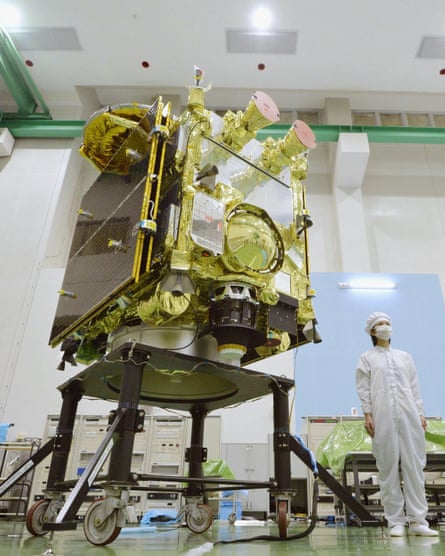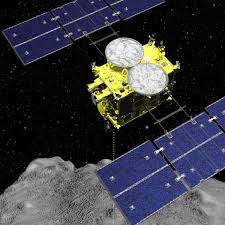A six-year mission will soon bring back a few grains of soil that could explain how water arrived on our planet
Source: The Guardian
In a few days, a capsule containing samples of soil from a distant asteroid will be released by a robot spaceship and dropped into Earth’s upper atmosphere. If all goes well, the container will parachute safely on to the Woomera test range in South Australia on 6 December, completing a mission that has involved a three-billion-mile journey across our solar system.
The information returned could help solve several major astronomical puzzles, say scientists – including the mystery of how water first appeared on our planet.
“Asteroids are the leftover building blocks from the formation of our solar system 4.6 billion years ago, and that makes them very important to science,” said Martin Lee, professor of planetary science at Glasgow University. “If you want to know what the planet was initially made of, you need to study asteroids.”
The Japanese probe Hayabusa 2 was launched six years ago and sent on a trajectory to the asteroid Ryugu which orbits the sun every 16 months at a distance of between 90 million and 131 million miles. For 18 months, it surveyed this 1,100-yard-wide lump of primordial rock before swooping close to its surface to collect a few scoops of soil. Then the probe fired its ion thrusters and began its year-long return to Earth.

Lee and his colleagues will be among the first groups of scientists to study samples of Ryugu soil when these are delivered – though the team will not have much to work on. “We expect to get a only few grains of material, each a few millimetres in diameter,” said geologist Luke Daly, a member of the Glasgow University team. “However, we won’t really know how much we will get until the Hayabusa capsule hits the deck: softly, we hope.”
Analysing the composition of an asteroid’s surface from a few specks of soil sounds ambitious. Nevertheless, the Glasgow team is confident. They plan to use a device called an atom probe which allows researchers to identify individual atoms in a sample. Given the vast numbers of atoms that make up even the tiniest of samples, this will require counting and analysing tens of millions of individuals atoms.
“Essentially, we will take a piece of soil and ablate its outer surface with a laser,” said Lee. “In other words, we will blast off its atoms, one by one. And then each of these atoms will be measured to determine the identity of that element and its particular isotope.
“We will also be able to reconstruct exactly where the atom was positioned in the sample, so we will get a three-dimensional image of the atomic structure of our sample.”
Engineers at the Japanese space agency, Jaxa, are still unsure how much material Hayabusa 2 has collected. Its predecessor mission, Hayabusa 1 – Hayabusa is the Japanese word for a peregrine falcon – in 2005, was plagued by engine failures and other technical problems and brought back very little material from its target, the asteroid Itokawa.
Hayabusa 2 should bring back much more, although its samples will first have to survive their return to Earth. This will begin when the probe releases a capsule carrying soil from Ryugu. Entering the atmosphere at 27,000mph, it will plunge toward Earth until, six miles above Australia, it will deploy a parachute and glide to the ground.
Samples will then be distributed to scientists round the world. “Apart from telling us what the early solar system was made of, they will also tell us what happens to rocks when they are bombarded by the solar wind for billions of years – and that is of crucial bearing in understanding the story of water in the solar system and, most importantly, on Earth,” added Lee.
The solar wind is a stream of protons and other sub-atomic particles emitted by the sun. Earth’s atmosphere shields us but in space the particles remorselessly batter surfaces that lack such protection. “This bombardment may be triggering the creation of water on asteroids,” added Daly. “Protons are, essentially, hydrogen ions and could be reacting with oxygen in rocks to create water molecules.”
Scientists are divided over the basic question of how water first appeared on our planet. Did it come with all the other materials that made up our planet 4.6bn years ago or was it brought here much later by icy comets crashing on our planet?
Recent space probes – such as the Rosetta mission which visited the comet 67P/Churyumov–Gerasimenko between 2014 and 2016 – have found water on these bodies. However, it is not quite like the water on Earth. These extraterrestrial samples contain higher levels of deuterium, an isotope of hydrogen, than is found in water from Earth and this has led many scientists to conclude our supply must have been here from the start.
“However, it may be that these ancient comets have not been the only source of water from elsewhere in the solar system and more recent reservoirs have been created by the solar wind battering rocks on asteroids,” said Lee.
“Water created there might have lower levels of deuterium, and that would explain how our oceans came to contain water with a different isotope signature. And, of course, studying the atoms from the rocks of asteroid Ryugu, which has been battered by the solar wind for billions of years, may well give us the answer.”
Source: The Guardian

































Leave a Comment
You must be logged in to post a comment.